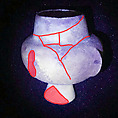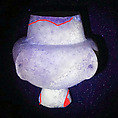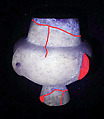On loan to The Met The Met accepts temporary loans of art both for short-term exhibitions and for long-term display in its galleries.
Marble vase with high foot and lug handles
Technical analysis: Ultraviolet-induced visible light luminescence examination, optical microscopy, X-ray fluorescence spectroscopy
This white marble jar has a hemispherical body with four, evenly-spaced, vertical lugs that are perforated for its suspension. It has a solid, slender, pedestalled foot that tapers upward and a slightly tapered, cylindrical neck. The jar is recomposed from several fragments and is complete except for two parts of the foot and two lug handles. Approximately half of the exterior surface is covered with a compact whitish layer of accretion. Other areas have patches of a light brown accretion and darker, root-like trails.
The round bodied jar with four equidistant, vertical pierced lugs on the shoulder, a tall tapering collared neck and pedestal foot reminded modern Cycladic islanders of the glass oil lamp, or ‘kandila’, that they suspended to illuminate their churches and chapels, hence their common modern designation. Pat Getz-Gentle observes that examples that are generally large with a broad mouth, broad body with short vertical lugs that end abruptly and do not conform with the body’s line, and a short, broad, and hollowed out pedestalled foot are likely to be works of an artist whom she calls Kandila Sculptor B.(1)
Sandy MacGillivray, Wendy Walker, Federico Carò
(1) See, Getz-Gentle, Pat.1996. Stone Vessels of the Cyclades in the Early Bronze Age. pp. 26-35, University Park: Pennsylvania State University Press.
This image cannot be enlarged, viewed at full screen, or downloaded.
This artwork is meant to be viewed from right to left. Scroll left to view more.









